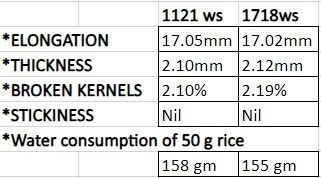1. General Overview
- 1718: A relatively new variety known for its high yield, resilience, and moderate grain length. It is considered versatile and economical for farmers.
- 1121: A premium variety of Basmati rice, celebrated globally for its extra-long grain, delicate aroma, and fluffy texture when cooked. Popular in high-end export markets.
- 1509: Another Basmati variety that matures faster than 1121. It is highly aromatic, has slightly shorter grains than 1121, and offers a good balance of quality and affordability.
2. Grain Characteristics
- 1718: Medium to long grain, non-aromatic. Its texture is firm when cooked, suitable for everyday meals and large-scale catering.
- 1121: Extra-long grain (the longest among Basmati varieties), very aromatic, and fluffy when cooked. Perfect for pilafs, biryanis, and festive dishes.
- 1509: Long grain, aromatic, with slightly shorter grains than 1121. Offers excellent elongation when cooked.
3. Aroma and Flavor
- 1718: Mild or no distinct aroma. Neutral flavor, making it versatile for various cuisines.
- 1121: Strong traditional Basmati aroma. Subtle nutty flavor, enhancing the appeal of traditional dishes.
- 1509: Distinct but milder aroma compared to 1121. Light nutty flavor, appealing for everyday and special dishes.
4. Cooking Characteristics
- 1718: Moderate elongation with minimal stickiness. Suitable for plain rice, curries, or fried rice.
- 1121: Exceptional elongation (grains double in size when cooked), non-sticky, and fluffy texture.
- 1509: Good elongation (slightly less than 1121), non-sticky, and fluffy. Cooks faster, making it convenient for restaurants and households.
5. Yield and Farming
- 1718: High-yield variety with resilience to pests and varying climatic conditions. Shorter maturity period, allowing multiple cropping.
- 1121: Moderate yield. Requires specific climatic and soil conditions. Longer maturity period (~145-150 days).
- 1509: High yield, shorter maturity period (~115-120 days) compared to 1121, making it more attractive to farmers.
6. Market and Pricing
- 1718: Affordable, primarily consumed domestically. Less competitive in the premium export market.
- 1121: Premium-priced due to its unmatched grain length, aroma, and quality. A favorite in international markets, especially the Middle East and Europe.
- 1509: Mid-range pricing, offering a balance between affordability and quality. Gaining popularity in both domestic and export markets.
7. Popular Uses
- 1718: Everyday meals, mass catering, and processed foods like rice-based snacks.
- 1121: High-end dishes like biryani, pilaf, and festive preparations. Preferred for export to premium markets.
- 1509: Ideal for biryani, pulao, and everyday meals in households and restaurants.
- 1718: A relatively new variety known for its high yield, resilience, and moderate grain length. It is considered versatile and economical for farmers.
- 1121: A premium variety of Basmati rice, celebrated globally for its extra-long grain, delicate aroma, and fluffy texture when cooked. Popular in high-end export markets.
- 1509: Another Basmati variety that matures faster than 1121. It is highly aromatic, has slightly shorter grains than 1121, and offers a good balance of quality and affordability.
2. Grain Characteristics
- 1718: Medium to long grain, non-aromatic. Its texture is firm when cooked, suitable for everyday meals and large-scale catering.
- 1121: Extra-long grain (the longest among Basmati varieties), very aromatic, and fluffy when cooked. Perfect for pilafs, biryanis, and festive dishes.
- 1509: Long grain, aromatic, with slightly shorter grains than 1121. Offers excellent elongation when cooked.
3. Aroma and Flavor
- 1718: Mild or no distinct aroma. Neutral flavor, making it versatile for various cuisines.
- 1121: Strong traditional Basmati aroma. Subtle nutty flavor, enhancing the appeal of traditional dishes.
- 1509: Distinct but milder aroma compared to 1121. Light nutty flavor, appealing for everyday and special dishes.
4. Cooking Characteristics
- 1718: Moderate elongation with minimal stickiness. Suitable for plain rice, curries, or fried rice.
- 1121: Exceptional elongation (grains double in size when cooked), non-sticky, and fluffy texture.
- 1509: Good elongation (slightly less than 1121), non-sticky, and fluffy. Cooks faster, making it convenient for restaurants and households.
5. Yield and Farming
- 1718: High-yield variety with resilience to pests and varying climatic conditions. Shorter maturity period, allowing multiple cropping.
- 1121: Moderate yield. Requires specific climatic and soil conditions. Longer maturity period (~145-150 days).
- 1509: High yield, shorter maturity period (~115-120 days) compared to 1121, making it more attractive to farmers.
6. Market and Pricing
- 1718: Affordable, primarily consumed domestically. Less competitive in the premium export market.
- 1121: Premium-priced due to its unmatched grain length, aroma, and quality. A favorite in international markets, especially the Middle East and Europe.
- 1509: Mid-range pricing, offering a balance between affordability and quality. Gaining popularity in both domestic and export markets.
7. Popular Uses
- 1718: Everyday meals, mass catering, and processed foods like rice-based snacks.
- 1121: High-end dishes like biryani, pilaf, and festive preparations. Preferred for export to premium markets.
- 1509: Ideal for biryani, pulao, and everyday meals in households and restaurants.
Summary Table

Conclusion
- 1718: Best for cost-effective farming and everyday consumption, with high yields and resilience.
- 1121: Premium choice for high-quality export and special dishes, with unmatched grain length and aroma.
- 1509: A balanced option with high yield, shorter maturity period, and versatility, appealing to both domestic and export markets
- 1718: Best for cost-effective farming and everyday consumption, with high yields and resilience.
- 1121: Premium choice for high-quality export and special dishes, with unmatched grain length and aroma.
- 1509: A balanced option with high yield, shorter maturity period, and versatility, appealing to both domestic and export markets





